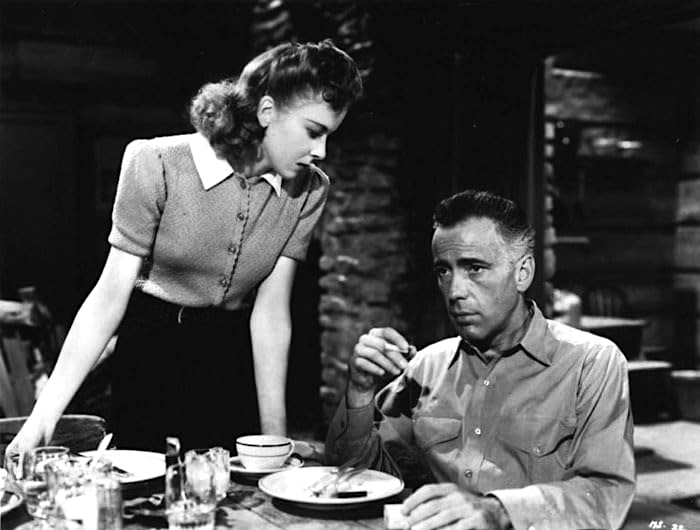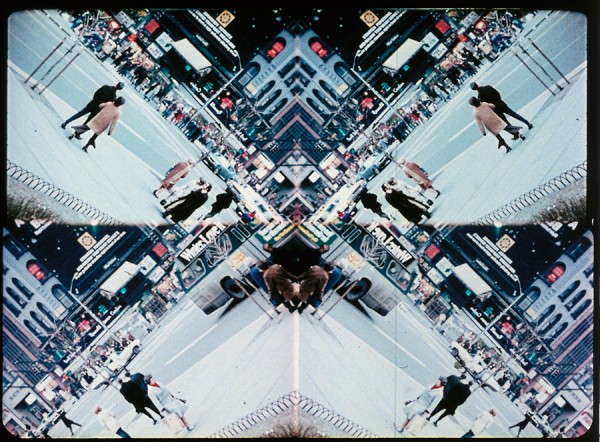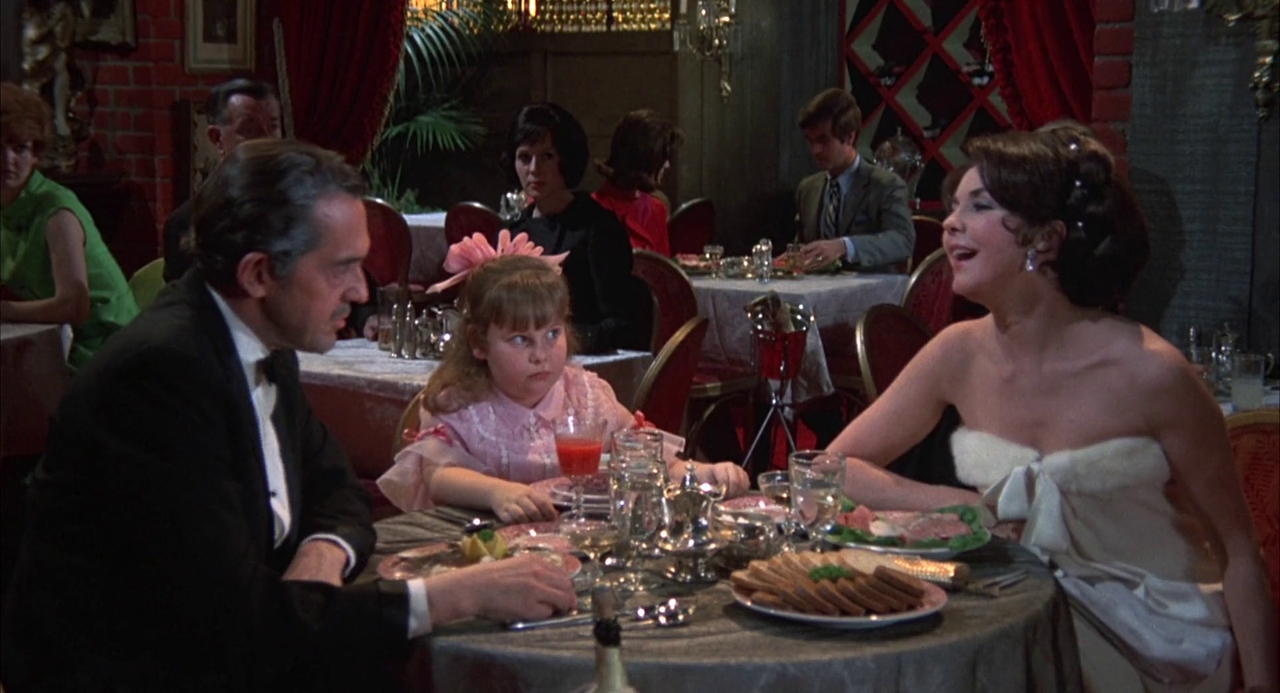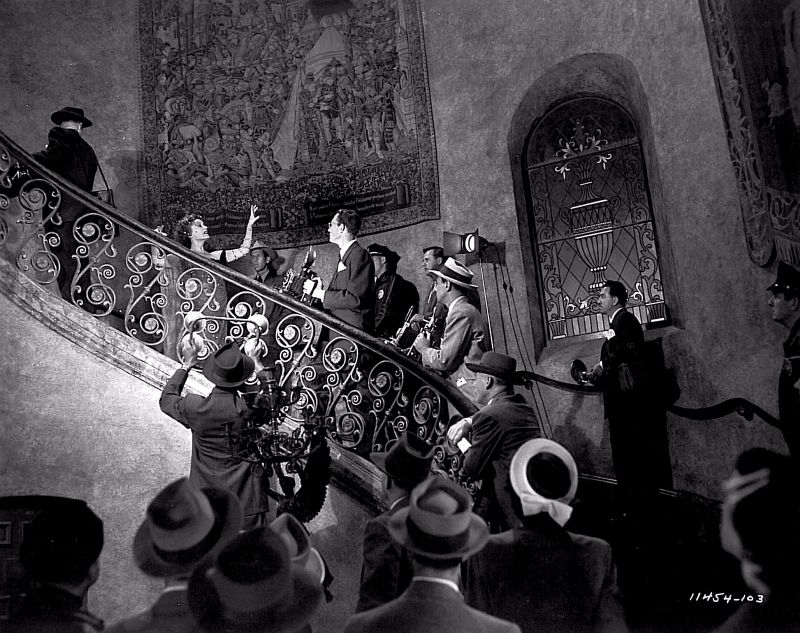Mikey and Nicky (Elaine May, 1976)
Jan
27
milk and cigarettes

The titular Mikey and Nicky sharing snacks, smokes, and sips at a tiny fast food table. There are piles of boxes with canned beer behind them. Mikey (Falk) cheesily grins at Nicky (Cassavetes). DPs: Bernie Abramson, Lucien Ballard, Jack Cooperman, Jerry File & Victor J. Kemper.
usa
– Do you play?
– Try me.The Thomas Crown Affair (Norman Jewison, 1968)
Jan
26
champagne

A production photo showing Thomas Crown (McQueen) and Vicki Anderson (Dunaway) sharing foods and drinks. Them seem enthralled with each other. DP: Haskell Wexler.
“Roy, this is the land of milk and honey for the health racket. Every woman in California thinks she's either too fat or too thin or too something.”High Sierra (Raoul Walsh, 1940)
Jan
19

Roy Earle (Bogart) pensively smoking an after-meal cigarette while Marie Garson (Lupino) looks on. DP: Tony Gaudio.
– 'Doc' Banton
“My cinematic excreta is of four varieties:–batiked abstractions made directly on film between 1939 and 1946; optically printed non-objective studies composed around 1950; semi-realistic animated collages made as part of my alchemical labors of 1957 to 1962; and chronologically superimposed photographs of actualities formed since the latter year. All these works have been organized in specific patterns derived from the interlocking beats of the respiration, the heart and the EEG Alpha component and they should be observed together in order, or not at all, for they are valuable works, works that will live forever—they made me gray.”Mahagonny [Number 18] (Harry Smith, 1980)
Dec
22
राष्ट्रिय गणित दिवस

A kaleidoscopic New York street scene. Mahagonny was “made to be displayed with four separate 16 mm projectors onto a single screen or onto two billiard tables suspended over a boxing ring” (Kevin Arrow, see link below).
A mathematics focused movie for National Mathematics Day (India)
Mahagonny is filmmaker, artist, musicologist, and alchemist Harry Smith's mathematical analysis of Marcel Duchamp's masterpiece La mariée mise à nu par ses célibataires, même [The Bride Stripped Bare by Her Bachelors, Even], aka Le Grand Verre [The Large Glass], which was completed in 1923. It is set to Brecht and Weill's opera Aufstieg und Fall der Stadt Mahagonny [Rise and Fall of the City of Mahagonny] from 1930, which was an opera Smith was obsessed with while living in New York's Chelsea Hotel.
– Harry Smith, via
Read an interview with Jonas Mekas about Harry Smith and his Mahagonny.
“We say hip, hooray,
Hip, hip hooray,
For fat!”Angel, Angel, Down We Go [Cult of the Damned (Robert Thom, 1969)
Dec
22

A chubby, piggy pink-dressed debutante (Joan Calhoun) flanked by her uppity-class parents (Charles Aidman and Jennifer Jones) in a fancy restaurant. The kid gives her mother the side eye. Other eaters look on in shock. DP: John F. Warren.
– Barry Mann & Cynthia Weil, The Fat Song
“I am big. It's the pictures that got small.”Sunset Boulevard (Billy Wilder, 1950)
Dec
21
Short Girl Appreciation Day

Norma Desmond (Gloria Swanson) descending an ornate staircase. The size of the set gives you an approximate idea of her height. Even when several steps above him, Swanson's dwarfed by the photographer in the dark suit and glasses. DP: John F. Seitz.
The main character is a “short girl” [I do not agree with the infantilizing wording] on Short Girl Appreciation Day (USA)
The great Gloria Swanson (4'11” – 5ft 2 / 1,49 m) – fabulously decked out by Edith Head (5'1” / 1,55 m) with an endless parade of platform shoes – in Billy Wilder's Sunset Blvd. (1950).
– Norma Desmond
Also starring, Buster Keaton, who was 5'5” / 1,65 m.
– This guy's got a lot of class. – Yeah? If he's got so much class, what's he doin' with you?Beyond a Reasonable Doubt (Fritz Lang, 1956)
Dec
18
late late night dinner

Dolly Moore (Barbara Nichols) and girlfriends amuse themselves over late late-night dinner. DP: William E. Snyder.
“Come Senators, Congressmen,
Please heed the call,
Don't stand in the doorway,
Don't block up the hall”Crisis: Behind a Presidential Commitment (Robert Drew, 1963)
Dec
14
Alabama Day

Bobby on the phone, seen from the back. DP: Gregory Shuker.
Alabama Day: filmed in Alabama.
In what he dubbed “Stand in the Schoolhouse Door”, George Wallace, Alabama governor, blocked Black students from walking into the University so he could uphold his inaugural promise of “segregation now, segregation tomorrow, segregation forever”. This prompted a national crisis, resulting in the President issuing Executive Order 11111, making the #NationalGuard step in.
– Bob Dylan, The Times They Are a-Changin (1964)
In a then-groundbreaking new documentary format, Robert Drew and associates followed President John F. Kennedy and Attorney General Robert F. Kennedy during the crisis. And they filmed everything; from tense phone calls, private discussions, private moments (one of RFK's daughters on the phone with a bemused “Kerry”, Dept. Nicholas Katzenbach), and many, many shots in which nothing – which is everything – is said.
“America is as psychotic as it is powerful and violence is the only goddamn thing that will command your attention.”Punishment Park (Peter Watkins, 1971)
Dec
13
U.S. National Guard Birthday

Military men arresting one of the dissidents. A man in black uniform and white helmet interacts directly with the camera c.q. the viewer. DPs: Joan Churchill & Peter Smokler.
It's the U.S. National Guard Birthday (USA) and the National Guard shows up.
A European camera crew follows a diverse group of American minor dissidents – pacifists, feminists, communists – who are given the choice to spend decades in federal prison, or three days in Bear Mountain Punishment Park, chased by National Guardsmen and law enforcement officers. If they manage to capture the American flag, they're free to go.
– Defendant Lee Robert Brown
While the washed-out 16mm footage and references to #Nixon may tell you otherwise, Punishment Park remains a gut-punching portrait of a timeless America.
“Can you smell the garlic?”Garlic Is as Good as Ten Mothers (Les Blank, 1980)
Dec
12
National 12 Hour Fresh Breath Day

Three representatives of the garlic festival. Their tees read: THE GARLIC TO SHARE WITH A FRIEND, MINE DOESN'T STINK, and WE LEAVE YOU BREATHLESS. DP: Les Blank.
Someone has bad breath on National 12-hour Fresh Breath Day (USA)
“When he shows the 1978 film Always for Pleasure, about the food, music and indigenous culture of New Orleans, [Les Blank] has been known to whip up a pot of red beans and rice in the back of the theatre. [cont. below]
– Alice Waters. During screenings, the audience would reply with “YES!”
“At presentations […] Blank can occasionally be spied tossing several heads of garlic into a toaster oven so that the aroma wafts over the audience at just the right mouth-watering moment.” (via)